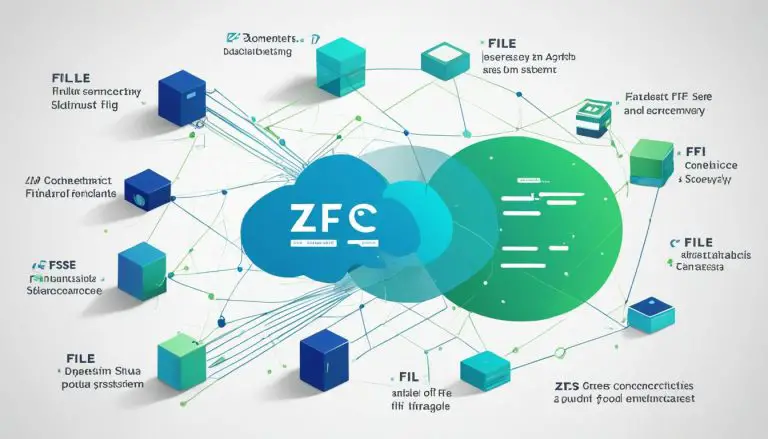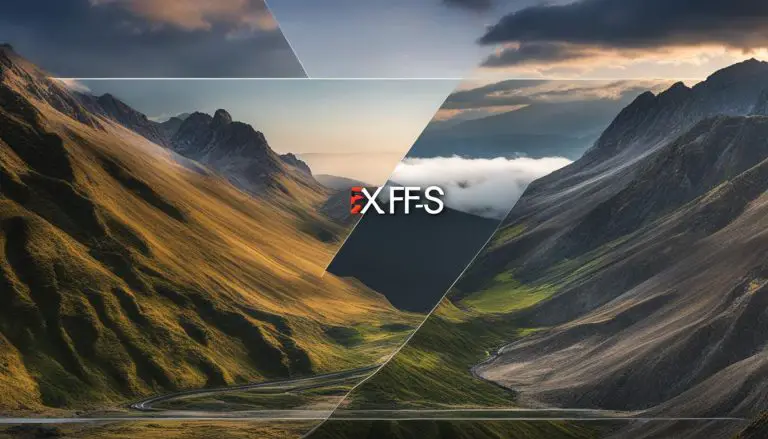Exploring the XFS Filesystem: An In-Depth Look
Welcome to the first section of our series on the XFS Filesystem – What is the XFS Filesystem, XFS Filesystem overview, Understanding XFS Filesystem. In this article, we will take a closer look at this highly scalable and high-performance file journaling file system. Originally designed at Silicon Graphics, Inc in 1993, XFS was later ported to the Linux kernel in 2001 and has since become the default filesystem for numerous Linux distributions, including RHEL, Oracle Linux, and CentOS.
The XFS Filesystem was specifically created to support extremely large filesystems, with sizes reaching up to 16 exabytes, and file sizes up to 8 exabytes. This makes it an ideal choice for enterprise systems and applications that require efficient storage and management of massive amounts of data. XFS features metadata journaling, de-fragmentation, and the unique ability to enlarge the filesystem while it is mounted and active, providing flexibility and scalability for changing storage needs.
Throughout this series, we will explore the key features, benefits, and performance optimizations of the XFS Filesystem. We will also delve into its capabilities for handling high throughput file I/O, quick recovery after a system crash, and efficient space management. By the end of this series, you will have a comprehensive understanding of the XFS Filesystem and its suitability for various storage and data management requirements.
Key Takeaways
- XFS is a highly scalable and high-performance file system originally designed at Silicon Graphics, Inc in 1993.
- It is the default filesystem on popular Linux distributions such as RHEL, Oracle Linux, and CentOS.
- XFS supports extremely large filesystems and files, with sizes up to 16 exabytes.
- The filesystem features metadata journaling, de-fragmentation, and the ability to enlarge the filesystem while mounted and active.
- Throughout this series, we will explore the key features, benefits, and performance optimizations of the XFS Filesystem.
Key Features of the XFS Filesystem
When it comes to the XFS Filesystem, there are several key features that set it apart from other file systems. Let’s take a closer look at some of these features:
Extent-based and Stripe-aware Allocation Schemes
The XFS Filesystem supports extent-based allocation schemes, which improves performance by allocating disk space in larger chunks. This reduces fragmentation and improves data access efficiency. Additionally, XFS is stripe-aware, meaning it can take advantage of RAID striping configurations to optimize data placement and improve performance on storage systems with multiple disks.
Delayed Allocation and Space Pre-allocation
XFS utilizes delayed allocation, a technique that delays the allocation of disk space until it is actually needed. This helps to optimize disk utilization and improve performance by reducing unnecessary disk writes. Furthermore, XFS supports space pre-allocation, which allows applications to reserve disk space in advance, ensuring availability and preventing fragmentation.
Subsecond Timestamps
XFS provides subsecond timestamps, allowing for precise time tracking and synchronization of file operations. This is especially beneficial for applications that require accurate timing, such as scientific data analysis, financial transactions, and media processing.
Extended Attributes and Quota Management
With XFS, you can attach extended attributes to files, enabling additional metadata to be associated with each file. This flexibility allows for customization and the implementation of specific functionality for different file types. XFS also supports quota management, including both quota journaling to ensure data integrity and project/directory quotas to restrict storage usage.
Universal Unique Identifier (UUID) Labeling
To distinguish XFS filesystems from one another, each filesystem is labeled with a Universal Unique Identifier (UUID). This unique identifier ensures that individual filesystems can be easily identified and managed, even across different devices and systems.
“The XFS Filesystem offers extensive features that enhance performance, flexibility, and data management capabilities.”
With its metadata journaling functionality, XFS also provides quick recovery after a system crash. This feature helps ensure data integrity and minimizes downtime in the event of an unexpected system failure. The combination of these key features makes XFS a powerful and reliable choice for handling large-scale storage and demanding workloads.
| Feature | Description |
|---|---|
| Extent-based and Stripe-aware Allocation | Chunk-based disk space allocation and optimized data placement for improved performance |
| Delayed Allocation and Space Pre-allocation | Optimizes disk utilization, reduces unnecessary disk writes, and prevents fragmentation |
| Subsecond Timestamps | Precise time tracking and synchronization for accurate timing of file operations |
| Extended Attributes and Quota Management | Customizable metadata attached to files and flexible storage usage control |
| Universal Unique Identifier (UUID) Labeling | Distinguishes XFS filesystems and facilitates identification and management |
Benefits of using the XFS Filesystem
The XFS Filesystem offers a range of advantages that make it a preferred choice for many users. From high scalability and performance to support for large filesystems, files, and directories, XFS delivers on various fronts.
- Efficient Space Management: XFS provides efficient space management, allowing for optimal utilization of available storage resources.
- Parallelism in File and Block Allocation: With support for parallelism, XFS enables efficient allocation of files and blocks, enhancing overall performance.
- Quick Recovery After a Crash: The XFS Filesystem has the capability to recover quickly and reliably after a system crash, ensuring minimal downtime and data loss.
- High Throughput File I/O: XFS is designed to handle high throughput file I/O, making it suitable for applications that require fast and consistent data access.
- Improved Performance and Scalability: Utilizing B+ trees instead of linear lookup structures, XFS enhances performance and scalability, especially when working with large datasets.
- Support for Extended Attributes: XFS enables the use of extended attributes, allowing for the attachment of additional information to files and directories.
- Quota Management: XFS supports quota management, enabling administrators to allocate and control disk space usage for specific users or groups.
- Real-Time Files: XFS provides support for real-time files, allowing applications to access and modify data with time-sensitive requirements.
“The XFS Filesystem provides high scalability, efficient space management, and superior performance, making it an ideal choice for handling large-scale file storage and management.”

Overall, the XFS Filesystem offers numerous benefits that cater to the needs of modern data-intensive environments. Whether it’s managing massive amounts of data or ensuring fast and reliable access to files, XFS proves to be a robust and versatile choice for a wide range of applications.
XFS Filesystem Performance
The XFS Filesystem is widely recognized for its exceptional performance and optimization capabilities. It excels in handling large, parallel input/output (I/O) requests, making it an ideal choice for high-demand environments. By utilizing Direct Memory Access (DMA), XFS enables the direct transfer of data between user buffers and disk drives, minimizing latency and maximizing throughput.
To further enhance performance, XFS incorporates various optimization techniques, such as delayed allocation. This feature postpones the allocation of physical disk blocks until necessary, resulting in improved write performance and enhanced data contiguity. These optimizations ensure efficient utilization of storage resources and contribute to superior overall system performance.
Another key advantage of the XFS Filesystem is its ability to deliver high throughput file I/O. With speed capabilities exceeding 300 MB/sec, XFS enables rapid data transfer and retrieval. This high-performance capability is particularly beneficial for applications that require fast and efficient access to large files and datasets.
XFS has undergone continuous development and enhancement to elevate its performance and introduce new features. With each release, the XFS Filesystem evolves to meet the ever-increasing demands of modern computing environments, ensuring optimal performance and scalability.
Key Performance Features of the XFS Filesystem:
- Support for large, parallel I/O requests
- Direct Memory Access (DMA) for efficient data transfer
- Delayed allocation for improved write performance
- High throughput file I/O, exceeding 300 MB/sec
- Ongoing development and performance enhancements
By leveraging advanced performance optimizations and its ability to handle high-demand workloads, the XFS Filesystem stands as a robust solution for organizations seeking exceptional performance and scalability in their file storage and management systems.
| Feature | Benefit |
|---|---|
| Large, parallel I/O requests support | Enables efficient processing of concurrent read/write operations, enhancing system performance. |
| Direct Memory Access (DMA) | Minimizes data transfer latency by enabling direct communication between user buffers and disk drives. |
| Delayed allocation | Improves write performance and enhances data contiguity by optimizing block allocation. |
| High throughput file I/O | Facilitates fast and efficient data transfer, allowing for rapid access to large files and datasets. |
| Ongoing development and performance enhancements | Continual improvement of the XFS Filesystem ensures optimal performance and introduces new features. |
Conclusion
In conclusion, the XFS Filesystem is a highly scalable and high-performance file system that offers a range of key features and benefits. Supported by numerous Linux distributions and serving as the default filesystem for many enterprise systems, XFS stands out for its ability to handle remarkably large filesystems and files, efficient space management, and high throughput file I/O.
One of the notable strengths of XFS is its swift recovery after a crash, ensuring minimal downtime and data loss. Additionally, continuous performance improvements have further enhanced its capabilities over time, making it a robust choice for file storage and management.
Whether you are working with large-scale data, require efficient space utilization, or need high-performance file I/O, the XFS Filesystem is an ideal solution. Its broad compatibility and impressive track record in handling demanding workloads make it a reliable option for a wide range of applications.
FAQ
What is the XFS Filesystem?
The XFS Filesystem is a highly scalable, high-performance file journaling file system initially designed at Silicon Graphics, Inc in 1993. It was later ported to the Linux kernel in 2001 and is now supported by most Linux distributions.
What are the key features of the XFS Filesystem?
The key features of the XFS Filesystem include metadata journaling, defragmentation, support for extremely large filesystems and files, extent-based and stripe-aware allocation schemes, subsecond timestamps, support for extended attributes and quotas, and the ability to recover quickly after a system crash.
What are the benefits of using the XFS Filesystem?
The XFS Filesystem offers several benefits, including high scalability, high performance, support for large filesystems, files, and directories, efficient space management, support for extended attributes and quota management, and the ability to handle high throughput file I/O.
How does the XFS Filesystem perform?
The XFS Filesystem is known for its excellent performance. It supports large, parallel I/O requests, allows for direct data transfer between user buffers and disk drives using DMA, utilizes delayed allocation and other performance optimizations to improve write performance and data contiguity, and provides high throughput file I/O with speeds of over 300 MB/sec.
- About the Author
- Latest Posts
Mark is a senior content editor at Text-Center.com and has more than 20 years of experience with linux and windows operating systems. He also writes for Biteno.com






